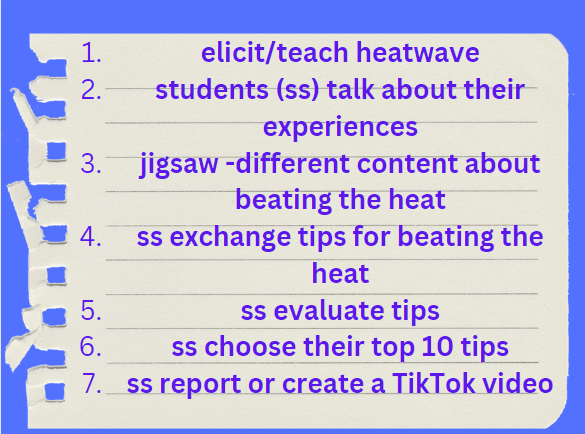Intro
Some weeks ago, I read Joanna’s lesson Heatwave advice from a doctor. This is a very good lesson for teaching B1 learners vocabulary and the use of should for giving advice.
I thought this was a great lesson idea. I teach upper intermediate and advanced students and I usually design jigsaw lessons, so here’s what I did:
The short version

Read more..
- I chose the title beat the heat. That’s a nice chunk and it rhymes, too.
2. I selected different types of content: videos, infographic and text. This was a useful differentiation. The text+infographic can be used with lower level students. The videos can be used with stronger students. Here are the resources I used:
text: https://www.nhs.uk/live-well/seasonal-health/heatwave-how-to-cope-in-hot-weather/
infographic: top tips to beat the heat infographic – Bing images
1st video:
2nd video
Procedure
- I provided the definition of heatwave: a prolonged period of abnormally hot weather.
- I elicited the word (you might need to teach it)
3. I asked students whether they’ve experienced a heatwave and how they beat the heat. I modelled the chunk, drew attention to the sound /i:/ in both content words. I reminded them beat is irregular – the past form is still beat. (You can use slide number 1 from Joanna’s presentation.)
3. I told my (4) students they will each engage with different content (video, infographic, text) and take notes of tips for beating the heat. I said it’s jigsaw activity, as they know what it is. If your students know the term, you can use it, too.
4. Next, they worked in a group (I just have 4 students, so 1 group), they exchanged the tips they got from their video/infographic/video.
5. They evaluated the different tips to beat the heat.
6. They compiled a list of their top 10 tips to beat the heat.
7. I ICEd emergent language. 🧊(Anderson, and McCutcheon, (2019). Identify inaccurate language, Capture or record it, Exploit it, clarify and practise it. I gave feedback on language+pronunciation.
Useful chunks
•Cool your environment
•Stay inside/indoors
•Exercise earlier
•Have lighter meals
•Avoid alcohol
•Stay in the shade
•Wear sunscreen
•Use electric fans
Be on the lookout for any symptoms
•Make an ice pack
•Have a hot shower! 😲
• wear lightweight, loose-fitting clothes
•Avoid salty, spicy foods
Optional 🎥
to make this task more motivating and authentic, students can record a video and post it on Tik Tok or other social media. It might also help them focus on accuracy, see below.
Input or output based-task?
This is a task-based lesson. The task is input-based, as learners process input via listening or reading and then do something with that information. I have read that this can be more suitable for lower level learners, however I’ve noticed my German learners prefer an input-first approach. They don’t feel so comfortable when they have to start with the productive task.
You may choose to make it output-based. This means starting with the productive task, which is learners creating a list of tips for beating the heat (in pairs). Perhaps the next step could be to play one video (a model task) and ask them to compare the two products.
➡️Your choice should depend on what you know about your learners’ abilities, preferences and expectations.
Ways to address accuracy in TBL lessons
Here are some ways to address accuracy according to Richards (2012):
before the task by:
- 📝pre-teaching language that can be useful (grammar/vocabulary/pronunciation)
- ⌚giving preparation time to brainstorm or make a mind map.
- 👀letting learners watch-listen to people doing the task. This chance for prior rehearsal is likely to ease the processing load learners will have when doing the task (Skehan, 1996).
during the task
- pair them/don’t group them; in large groups , students tend to be more concerned with fluency than accuracy.
- stage tasks into shorter more manageable sub–tasks.
after the task
- 🔁task repetition
- 🎙️public performance (Tik Tok video?).
- 🧊ICE any emergent language (Anderson, and McCutcheon, 2019). See above.
So..
I hope some of you find this useful. Let me know what you think in the comments!
References
Anderson, N. and McCutcheon, N., (2019). Activities For Task-Based Learning. Stuttgart: DELTA Publishing.
Duong, P.-T. et al. (2021) ‘Differential effects of input-based and output-based tasks on L2 vocabulary learning’, Canadian Journal of Applied Linguistics, 24(3), pp. 120–144. doi:10.37213/cjal.2021.31183.
Richards, J.C. and Renandya, W.A. (2012) ‘Addressing the Grammar Gap in Task Work’, in Methodology in language teaching: An anthology of current practice. New York: Cambridge University Press.
Skehan, P. (1996) A framework for the implementation of Task-based learning. Applied Linguistics, 17(1), 38-61.
https://www.teachingenglish.org.uk/professional-development/teachers/knowing-subject/d-h/jigsaw


Rachel thank you so much for such an interesting and practical lesson and for all your suggestions. You are a wonderful and generous source of brilliant ideas.
BTW the infographic you picked is by a foundation I personally met in Pakistan, Aman foundation, and this is so great…
Thank you for sharing!
https://i-care-foundation.org/charity/aman-foundation/
LikeLiked by 1 person
Wow! I had no idea! Small world! Thanks for stopping by, Laura L. 😍
LikeLike
I don’t have any insightful comments to make except for the fact that the plan is fantastic, and I’m sure you delivered it to the delight of the learners.🎈
My big take-aways are the addition of new words into my glossary of pedagogical terms; watch-listen and ICE (identify, capture and exploit + clarify & practise) any emergent language.
Thank you, Rachel. 🦚
LikeLiked by 1 person
Thank you for the mention and happy New Year, Joanna! Look forward to reading your blogposts in 2024!
LikeLike